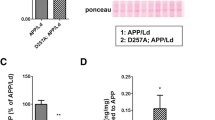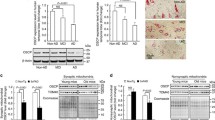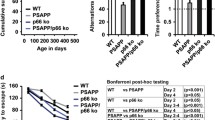Abstract
For decades, mitochondrial dysfunctions and the generation of reactive oxygen species have been proposed to promote the development and progression of the amyloid pathology in Alzheimer’s disease, but this association is still debated. It is unclear whether different mitochondrial dysfunctions, such as oxidative phosphorylation deficiency and oxidative stress, are triggers or rather consequences of the formation of amyloid aggregates. Likewise, the role of the different mitochondrial oxidative phosphorylation complexes in Alzheimer’s patients’ brain remains poorly understood. Previous studies showed that genetic ablation of oxidative phosphorylation enzymes from early age decreased amyloid pathology, which were unexpected results. To better model oxidative phosphorylation defects in aging, we induced the ablation of mitochondrial Complex III (CIIIKO) in forebrain neurons of adult mice with amyloid pathology. We found that mitochondrial Complex III dysfunction in adult neurons induced mild oxidative stress but did not increase amyloid beta accumulation. On the contrary, CIIIKO-AD mice showed decreased plaque number, decreased Aβ42 toxic fragment, and altered amyloid precursor protein clearance pathway. Our results support the hypothesis that mitochondrial dysfunctions alone, caused by oxidative phosphorylation deficiency, is not the cause of amyloid accumulation.






Similar content being viewed by others
Data Availability
The complete datasets used and/or analyzed during the current study are available from the corresponding author on request.
Abbreviations
- Aβ:
-
Amyloid beta
- AD:
-
Alzheimer’s disease
- APP/PS1:
-
Amyloid precursor protein (Mo/HuAPP695swe), presenilin 1 (PS1-dE9)
- ATP5a:
-
ATP synthase alpha-subunit gene
- BACE1:
-
Beta-secretase 1, beta-site APP cleaving enzyme 1
- BN-PAGE:
-
Blue native polyacrylamide gel electrophoresis
- CaMKIIα:
-
Calcium/calmodulin-dependent protein kinase II alpha
- COX1:
-
Cyclooxygenase 1 (cytochrome c oxidase)
- CS:
-
Citrate synthase
- CTF:
-
APP C-terminal fragment
- CytC:
-
Cytochrome C
- GFAP:
-
Glial fibrillary acidic protein
- Iba1:
-
Ionized calcium binding adaptor molecule 1
- LC3B:
-
Autophagy marker light chain 3
- mtDNA:
-
Mitochondrial DNA
- NDUFB8:
-
NADH:ubiquinone oxidoreductase subunit B8
- NDUFA9:
-
NADH:ubiquinone oxidoreductase subunit A9
- OXPHOS:
-
Oxidative phosphorylation
- PBS:
-
Phosphate-buffered saline
- PFA:
-
Paraformaldehyde
- PGC-1α:
-
Peroxisome proliferator-activated receptor gamma coactivator 1-alpha
- PVDF:
-
Polyvinylidene difluoride
- RISP:
-
Rieske iron sulfur protein
- ROS:
-
Reactive oxygen species
- RT:
-
Room temperature
- SDHA:
-
Succinate dehydrogenase complex dlavoprotein subunit A
- SDS-PAGE:
-
Sodium dodecyl sulfate polyacrylamide gel electrophoresis
- SOD2:
-
Superoxide dismutase 2
- TUJ1:
-
Neuron-specific class III beta-tubulin
- UQCRC1/Core1:
-
Ubiquinol-cytochrome C reductase core protein 1
- UQCRFS1:
-
Ubiquinol-cytochrome C reductase, Rieske iron-sulfur polypeptide 1
- VDAC1/Porin:
-
Voltage-dependent anion channel
References
Polanco JC et al (2018) Amyloid-beta and tau complexity — towards improved biomarkers and targeted therapies. Nat Rev Neurol 14(1):22–39
Swerdlow RH, Burns JM, Khan SM (2014) The Alzheimer’s disease mitochondrial cascade hypothesis: progress and perspectives. Biochim Biophys Acta 1842(8):1219–1231
Tapias V (2019) Editorial: Mitochondrial Dysfunction and Neurodegeneration. Front Neurosci 13:1372
Hou Y et al (2019) Ageing as a risk factor for neurodegenerative disease. Nat Rev Neurol 15(10):565–581
Bowling AC et al (1993) Age-dependent impairment of mitochondrial function in primate brain. J Neurochem 60(5):1964–1967
Hauptmann S et al (2009) Mitochondrial dysfunction: an early event in Alzheimer pathology accumulates with age in AD transgenic mice. Neurobiol Aging 30(10):1574–1586
Hong MG et al (2008) Transcriptome-wide assessment of human brain and lymphocyte senescence. PLoS One 3(8):e3024
Ross JM et al (2010) High brain lactate is a hallmark of aging and caused by a shift in the lactate dehydrogenase A/B ratio. Proc Natl Acad Sci USA 107(46):20087–20092
Yao J et al (2009) Mitochondrial bioenergetic deficit precedes Alzheimer’s pathology in female mouse model of Alzheimer’s disease. Proc Natl Acad Sci USA 106(34):14670–14675
Coskun PE, Beal MF, Wallace DC (2004) Alzheimer’s brains harbor somatic mtDNA control-region mutations that suppress mitochondrial transcription and replication. Proc Natl Acad Sci USA 101(29):10726–10731
Krishnan KJ et al (2012) Mitochondrial DNA deletions cause the biochemical defect observed in Alzheimer’s disease. Neurobiol Aging 33(9):2210–2214
Lin MT et al (2002) High aggregate burden of somatic mtDNA point mutations in aging and Alzheimer’s disease brain. Hum Mol Genet 11(2):133–145
Bennett JP Jr, Keeney PM (2020) Alzheimer’s and Parkinson’s brain tissues have reduced expression of genes for mtDNA OXPHOS Proteins, mitobiogenesis regulator PGC-1alpha protein and mtRNA stabilizing protein LRPPRC (LRP130). Mitochondrion 53:154–157
Chagnon P et al (1995) Distribution of brain cytochrome oxidase activity in various neurodegenerative diseases. NeuroReport 6(5):711–715
Chen JX, Yan SS (2010) Role of mitochondrial amyloid-beta in Alzheimer’s disease. J Alzheimers Dis 20 Suppl 2:S569–S578
Long J et al (2012) New evidence of mitochondria dysfunction in the female Alzheimer’s disease brain: deficiency of estrogen receptor-beta. J Alzheimers Dis 30(3):545–558
Mutisya EM, Bowling AC, Beal MF (1994) Cortical cytochrome oxidase activity is reduced in Alzheimer’s disease. J Neurochem 63(6):2179–2184
Holper L, Ben-Shachar D, Mann JJ (2019) Multivariate meta-analyses of mitochondrial complex I and IV in major depressive disorder, bipolar disorder, schizophrenia, Alzheimer disease, and Parkinson disease. Neuropsychopharmacology 44(5):837–849
Onyango IG, Khan SM, Bennett JP Jr (2017) Mitochondria in the pathophysiology of Alzheimer’s and Parkinson’s diseases. Front Biosci (Landmark Ed) 22:854–872
Kim SH et al (2000) Decreased levels of complex III core protein 1 and complex V beta chain in brains from patients with Alzheimer’s disease and Down syndrome. Cell Mol Life Sci 57(12):1810–1816
Kenney PM, Bennett JP Jr (2019) Alzheimer’s disease frontal cortex mitochondria show a loss of individual respiratory proteins but preservation of respiratory supercomplexes. Int J Alzheimers Dis 2019:4814783
Fisar Z et al (2019) Activities of mitochondrial respiratory chain complexes in platelets of patients with Alzheimer’s disease and depressive disorder. Mitochondrion 48:67–77
Guglielmotto M et al (2009) The up-regulation of BACE1 mediated by hypoxia and ischemic injury: role of oxidative stress and HIF1alpha. J Neurochem 108(4):1045–1056
Leuner K et al (2012) Mitochondrion-derived reactive oxygen species lead to enhanced amyloid beta formation. Antioxid Redox Signal 16(12):1421–1433
Paola D et al (2000) Oxidative stress induces increase in intracellular amyloid beta-protein production and selective activation of betaI and betaII PKCs in NT2 cells. Biochem Biophys Res Commun 268(2):642–646
Tamagno E et al (2002) Oxidative stress increases expression and activity of BACE in NT2 neurons. Neurobiol Dis 10(3):279–288
Anandatheerthavarada HK et al (2003) Mitochondrial targeting and a novel transmembrane arrest of Alzheimer’s amyloid precursor protein impairs mitochondrial function in neuronal cells. J Cell Biol 161(1):41–54
Calkins MJ et al (2011) Impaired mitochondrial biogenesis, defective axonal transport of mitochondria, abnormal mitochondrial dynamics and synaptic degeneration in a mouse model of Alzheimer’s disease. Hum Mol Genet 20(23):4515–4529
Casley CS et al (2002) Beta-amyloid inhibits integrated mitochondrial respiration and key enzyme activities. J Neurochem 80(1):91–100
Devi L et al (2006) Accumulation of amyloid precursor protein in the mitochondrial import channels of human Alzheimer’s disease brain is associated with mitochondrial dysfunction. J Neurosci 26(35):9057–9068
Hansson Petersen CA et al (2008) The amyloid beta-peptide is imported into mitochondria via the TOM import machinery and localized to mitochondrial cristae. Proc Natl Acad Sci USA 105(35):13145–13150
Manczak M et al (2006) Mitochondria are a direct site of A beta accumulation in Alzheimer’s disease neurons: implications for free radical generation and oxidative damage in disease progression. Hum Mol Genet 15(9):1437–1449
Reddy PH, Beal MF (2008) Amyloid beta, mitochondrial dysfunction and synaptic damage: implications for cognitive decline in aging and Alzheimer’s disease. Trends Mol Med 14(2):45–53
Wang X et al (2008) Amyloid-beta overproduction causes abnormal mitochondrial dynamics via differential modulation of mitochondrial fission/fusion proteins. Proc Natl Acad Sci USA 105(49):19318–19323
Fukui H et al (2007) Cytochrome c oxidase deficiency in neurons decreases both oxidative stress and amyloid formation in a mouse model of Alzheimer’s disease. Proc Natl Acad Sci USA 104(35):14163–14168
Pinto M et al (2013) Mitochondrial DNA damage in a mouse model of Alzheimer’s disease decreases amyloid beta plaque formation. Neurobiol Aging 34(10):2399–2407
Jankowsky JL et al (2001) Co-expression of multiple transgenes in mouse CNS: a comparison of strategies. Biomol Eng 17(6):157–165
Madisen L et al (2010) A robust and high-throughput Cre reporting and characterization system for the whole mouse brain. Nat Neurosci 13(1):133–140
Waypa GB et al (2013) Superoxide generated at mitochondrial complex III triggers acute responses to hypoxia in the pulmonary circulation. Am J Respir Crit Care Med 187(4):424–432
Wang J et al (2003) Gender differences in the amount and deposition of amyloidbeta in APPswe and PS1 double transgenic mice. Neurobiol Dis 14(3):318–327
Zhou CN et al (2018) Sex differences in the white matter and myelinated fibers of APP/PS1 mice and the effects of running exercise on the sex differences of AD mice. Front Aging Neurosci 10:243
Mifflin MA et al (2021) Sex differences in the IntelliCage and the Morris water maze in the APP/PS1 mouse model of amyloidosis. Neurobiol Aging 101:130–140
Dominguez S et al (2020) Sex differences in the phosphoproteomic profiles of APP/PS1 mice after chronic unpredictable mild stress. J Alzheimers Dis 74(4):1131–1142
Li X et al (2016) Sex differences between APPswePS1dE9 mice in A-beta accumulation and pancreatic islet function during the development of Alzheimer’s disease. Lab Anim 50(4):275–285
Schmittgen TD, Livak KJ (2008) Analyzing real-time PCR data by the comparative C(T) method. Nat Protoc 3(6):1101–1108
Barrientos A, Fontanesi F, Diaz F (2009) Evaluation of the mitochondrial respiratory chain and oxidative phosphorylation system using polarography and spectrophotometric enzyme assays. Curr Protoc Hum Genet Chapter 19:Unit19 3
Jankowsky JL et al (2004) Mutant presenilins specifically elevate the levels of the 42 residue beta-amyloid peptide in vivo: evidence for augmentation of a 42-specific gamma secretase. Hum Mol Genet 13(2):159–170
Choi CI et al (2014) Simultaneous deletion of floxed genes mediated by CaMKIIalpha-Cre in the brain and in male germ cells: application to conditional and conventional disruption of Goalpha. Exp Mol Med 46:e93
Jones KJ et al (2018) Rapid, experience-dependent translation of neurogranin enables memory encoding. Proc Natl Acad Sci USA 115(25):E5805–E5814
Garrido-Garcia A et al (2019) Neurogranin expression is regulated by synaptic activity and promotes synaptogenesis in cultured hippocampal neurons. Mol Neurobiol 56(11):7321–7337
Mohajeri MH, Saini KD, Nitsch RM (2004) Transgenic BACE expression in mouse neurons accelerates amyloid plaque pathology. J Neural Transm (Vienna) 111(3):413–425
Li R et al (2004) Amyloid beta peptide load is correlated with increased beta-secretase activity in sporadic Alzheimer’s disease patients. Proc Natl Acad Sci USA 101(10):3632–3637
Kaspar S, Oertlin C, Szczepanowska K, Kukat A, Senft K, Lucas C, Brodesser S, Hatzoglou M, Larsson O, Topisirovic I, Trifunovic A (2021) Adaptation to mitochondrial stress requires CHOP-directed tuning of ISR. Sci Adv 7(22)
Misrani A, Tabassum S, Yang L (2021) Mitochondrial dysfunction and oxidative stress in Alzheimer’s disease. Front Aging Neurosci 13:617588
Diaz F et al (2012) A defect in the mitochondrial complex III, but not complex IV, triggers early ROS-dependent damage in defined brain regions. Hum Mol Genet 21(23):5066–5077
Sheng B et al (2012) Impaired mitochondrial biogenesis contributes to mitochondrial dysfunction in Alzheimer’s disease. J Neurochem 120(3):419–429
Terada T et al (2021) Mitochondrial complex I abnormalities is associated with tau and clinical symptoms in mild Alzheimer’s disease. Mol Neurodegener 16(1):28
Peralta S, Pinto M, Arguello T , Garcia S, Diaz F, Moraes CT (2020) Metformin delays neurological symptom onset in a mouse model of neuronal complex I deficiency. JCI Insight 5(21)
Pickrell AM et al (2011) The striatum is highly susceptible to mitochondrial oxidative phosphorylation dysfunctions. J Neurosci 31(27):9895–9904
Zhang L et al (2015) Modulation of mitochondrial complex I activity averts cognitive decline in multiple animal models of familial Alzheimer’s Disease. EBioMedicine 2(4):294–305
Kukreja L et al (2014) Increased mtDNA mutations with aging promotes amyloid accumulation and brain atrophy in the APP/Ld transgenic mouse model of Alzheimer’s disease. Mol Neurodegener 9:16
Virtuoso A, Colangelo AM, Maggio N, Fennig U, Weinberg N, Papa M, De Luca C (2021) The spatiotemporal coupling: regional energy failure and aberrant proteins in neurodegenerative diseases. Int J Mol Sci 22(21)
Mouton-Liger F et al (2012) Oxidative stress increases BACE1 protein levels through activation of the PKR-eIF2alpha pathway. Biochim Biophys Acta 1822(6):885–896
Tamagno E et al (2008) Oxidative stress activates a positive feedback between the gamma- and beta-secretase cleavages of the beta-amyloid precursor protein. J Neurochem 104(3):683–695
Lopez Sanchez MIG et al (2017) Amyloid precursor protein drives down-regulation of mitochondrial oxidative phosphorylation independent of amyloid beta. Sci Rep 7(1):9835
Mao P et al (2012) Mitochondria-targeted catalase reduces abnormal APP processing, amyloid beta production and BACE1 in a mouse model of Alzheimer’s disease: implications for neuroprotection and lifespan extension. Hum Mol Genet 21(13):2973–2990
McManus MJ, Murphy MP, Franklin JL (2011) The mitochondria-targeted antioxidant MitoQ prevents loss of spatial memory retention and early neuropathology in a transgenic mouse model of Alzheimer’s disease. J Neurosci 31(44):15703–15715
Ross JM, Olson L, Coppotelli G (2015) Mitochondrial and ubiquitin proteasome system dysfunction in ageing and disease: two sides of the same coin? Int J Mol Sci 16(8):19458–19476
Huang Q et al (2013) Negative regulation of 26S proteasome stability via calpain-mediated cleavage of Rpn10 subunit upon mitochondrial dysfunction in neurons. J Biol Chem 288(17):12161–12174
Meul T et al (2020) Mitochondrial regulation of the 26S proteasome. Cell Rep 32(8):108059
Livnat-Levanon N et al (2014) Reversible 26S proteasome disassembly upon mitochondrial stress. Cell Rep 7(5):1371–1380
Hohn A, Konig J, Grune T (2013) Protein oxidation in aging and the removal of oxidized proteins. J Proteomics 92:132–159
Adav SS, Park JE, Sze SK (2019) Quantitative profiling brain proteomes revealed mitochondrial dysfunction in Alzheimer’s disease. Mol Brain 12(1):8
Crouch PJ et al (2006) Copper-dependent inhibition of cytochrome c oxidase by Abeta(1–42) requires reduced methionine at residue 35 of the Abeta peptide. J Neurochem 99(1):226–236
Funding
This work was supported primarily by the Florida Biomedical Foundation Ed and Ethel Moore Alzheimer’s Disease Research Program grant 5AZ06 (CTM), the National Institute of Health Grants K01AG057815 (MP), and 1R01NS079965 (CTM). The following grants also helped support this work: NIH grants 5R01EY010804, 1R01AG036871, R33ES025673, and the Muscular Dystrophy Association.
Author information
Authors and Affiliations
Contributions
MP designed the research, performed the experiments, analyzed, and interpreted data, and wrote the manuscript. FD performed BN-PAGE analysis, enzymatic activity, and contributed intellectually to the research. NN performed qPCR analysis. CSG and PI assisted in plaque counting. RB contributed intellectually to the research. CTM planned the project together with MP and contributed to the writing of the manuscript. All authors read and approved the final manuscript. Francisca Diaz and Placido Illiano passed away before the submission of the manuscript.
Corresponding authors
Ethics declarations
Ethics Approval
All experiments and animal husbandry were performed according to a protocol approved by the University of Miami Institutional Animal Care and Use Committee.
Consent to Participate
Not applicable.
Consent for Publication
All authors approved the publication.
Competing Interests
The authors have no relevant financial or non-financial interests to disclose.
Additional information
Publisher's Note
Springer Nature remains neutral with regard to jurisdictional claims in published maps and institutional affiliations.
Francisca Diaz deceased in March 2021.
Placido Illiano deceased in February 2022.
Rights and permissions
Springer Nature or its licensor holds exclusive rights to this article under a publishing agreement with the author(s) or other rightsholder(s); author self-archiving of the accepted manuscript version of this article is solely governed by the terms of such publishing agreement and applicable law.
About this article
Cite this article
Pinto, M., Diaz, F., Nissanka, N. et al. Adult-Onset Deficiency of Mitochondrial Complex III in a Mouse Model of Alzheimer’s Disease Decreases Amyloid Beta Plaque Formation. Mol Neurobiol 59, 6552–6566 (2022). https://doi.org/10.1007/s12035-022-02992-3
Received:
Accepted:
Published:
Issue Date:
DOI: https://doi.org/10.1007/s12035-022-02992-3




